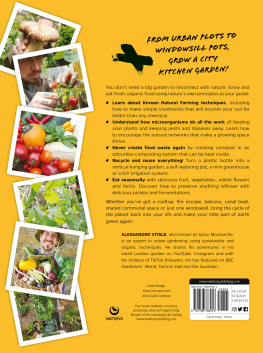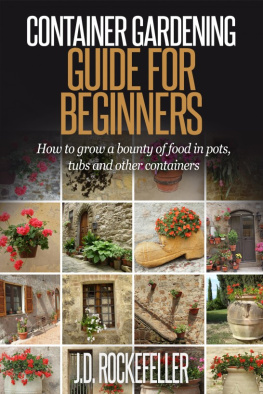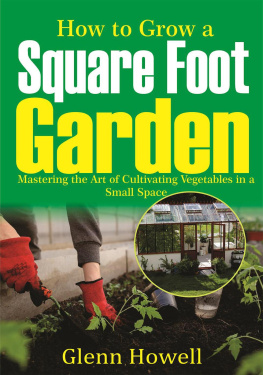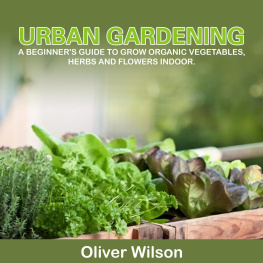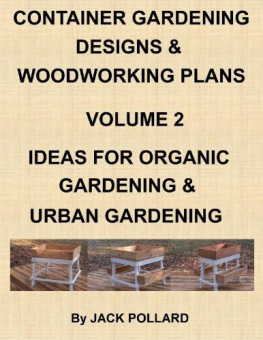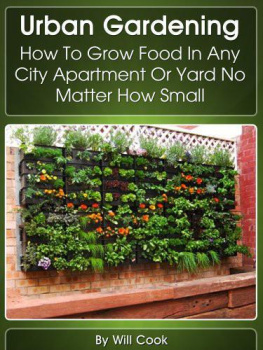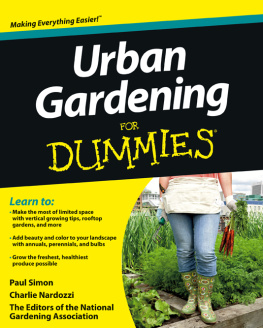Contents
For the gardeners of:
my past my parents, Eve and Ray
my present my sister, Shirley and
hopefully, my and their future my great-nieces,
Tallulah and Sierra
Gardening gets us all in the end. Resistance is futile: once youve grazed on un-ripened raspberries or plucked peppery perennial rocket from your own patch, theres no going back.
Gardening tightens its tendrils around us in different ways, at different times in our lives. Children raised by country mums who dragged them on interminable garden tours suddenly find themselves inflicting the same fate on their own kids. Newlyweds are now given gardening vouchers instead of crystal fruit-salad bowls. First homebuyers plant fruit trees and build raised beds instead of pouring concrete patios. Young parents want to grow organic vegetables, and seek advice from old chaps who compete to grow the biggest carrots.
Growing your own food, suddenly, surprisingly, is the zeitgeist.
Living off the land keeping chooks and bees and swapping seeds holds increasing appeal to those of us who yearn for a simpler, more sustainable way of life. Who doesnt know a corporate high-flyer who has put down their iPhone and put on a pinny to try their hand at pickling and preserving? Some of us choose to up sticks and return to our rural roots. Others, like Fionna, seek out allotments within coo-ee of their city apartments.
When I first met Fionna, she was a well-known florist. Her contemporary bouquets graced corporate foyers and the pages of glossy magazines. But who would have guessed that, one day, shed prefer to plant flowers for bees and beneficial insects, or eat their silken petals in salads?
Fionnas adventures from novice green thumb to fully-fledged Green Granny are a delight. As she soon discovers, gardening isnt all wine and roses. There are slugs and snails, and crops that fail. There are curmudgeonly sticklers for rules and regulations. There are vandals bastards! and small victories. And there are so many memories. Her recollection of a cabbage from her mothers garden, so large we could sit on it like a one-legged stool, took me back to my mums colossal cauliflowers, as big as basketballs.
Fionna describes herself as a frugal forager. Shes also a crafty pickler and preserver. When I judged the giant vegetables at the annual Grow n Show competition at Kelmarna Gardens in central Auckland last summer, I couldnt resist sampling the jams and chutneys, too. Fionna won every category she entered, and her whole green preserved figs firm, zesty and full of figgy flavour scooped the Best in Show rosette. Do try her recipe (its on page 267), especially if you struggle to beat the birds to your figs before theyre fully ripe.
My measure of a good gardening book? Dog-eared pages, marking seeds to buy, heritage varieties to source, seasonal recipes to try. (Who would have thought to pickle Jerusalem artichokes? Not I, until now.) For me, gardening is all about sharing. Community gardens would be nothing without community-spirited gardeners who share their advice, their experience and the occasional self-combusting bottle of worms wee. As Fionna muses, gardeners seem to be generous people. And to that I must add, welcome to the fold.
Lynda Hallinan
Editor-at-large
New Zealand Gardener
To own a bit of ground, to scratch it with a hoe,
to plant seeds and watch their renewal of life
this is the commonest delight of the race,
the most satisfactory thing a man can do.
Charles Dudley Warner (18291900),
American essayist and novelist
A display tent at the Grey Lynn Park Festival caught my eye. It had engaging photographs of vegetable gardens and happy gardeners displayed around the tent sides, cushions on the ground; hippyish. Anna and Pierre chatted to festival-goers. And there were seedlings available in exchange for a koha.
The Grey Lynn Park Festival is held every November. Market stalls have New Zealand-made goods, and showcase the works of New Zealand artists, painters, sculptors and designers, along with produce stalls. Its a chance for people to bring their products and their passions to the public. Community groups and clubs get the chance to do some fundraising and profile themselves. Grey Lynn Community Gardens have a tent promoting their gardens and letting the public know what their organic community garden is all about.
When I tell friends about my new-found patch of land, most of them have never heard of community gardens. I hadnt either in New Zealand until I came upon my one. Ive seen allotments in England, and love train journeys there where I see the back views of homes where there are flourishing tiny private gardens and occasionally large, neat allotments. I dont know how many community gardens there are here; when I check the internet I see incomplete lists of gardens inviting new ones to add their addresses; they are clearly popping up all the time. But before I joined mine, I did not know of any and believe that not many other people do either.
Near ours is the new Wilton Street garden that started a year ago as a Grey Lynn 2030 project. GL2030 is part of the transition town movement in response to climate change, peak oil (when the supply runs out), etc. It aims to have a sustainable and vibrant community by 2030, with a focus on waste reduction, food production, farmers markets, community gardens, traffic calming, and more. The Wilton Street garden is on what had been a patch of heavily overgrown, jasmine-tangled land that had lain vacant for years. It took six months to clear, and now has stretches of garden, raised planter beds and a picket fence. Behind an old trellis, a wilderness area has been left for native flora and fauna. As I write, the gardeners are in the process of developing a community composting station and establishing a permanent water supply using donated tanks connected to the spouting of an adjacent shop. I joined a garden that had started like that, too, but am lucky that I have inherited years of work that has already established it.
Overseas experience shows that there are many reasons why members of a community come together and create a garden. Some reasons can be loosely described as ecological; others as social or community development. Overseas, community gardens provide places for socializing and relaxing; in New Zealand most people still have access to open spaces to relax. Overseas, seats, play areas and art have been added to gardens to increase their value as community centres, and the activity of gardening brings people together from across the social strata, building stronger, more integrated communities. At our gardens, there is an adjoining childrens play area on church land; our art is a set of low-flying ceramic ducks, a rusty horseshoe and sometimes a fabric banner; and there are no seats but I love it. For me, the rewards are fresh vegetables, recreation and probably therapy I always leave feeling better than I did when I arrived. Its made me more environmentally aware, too.
Living in a second-floor apartment of a large apartment block I have no garden lots of edibles in pots on two balconies, but no soil to really get my hands into. Ive thought for years that a veggie garden might be a retirement goal, but didnt dream that there could be a plot with my name on it just around the corner.

After talking to Anna and Pierre at the festival, I decide to go along to the community gardens for their weekly Growing Together gardening session. I asked if I could have a plot of my own. No, sorry, none available, but Id be welcome to come and muck in at the joint communal gardens, meet some people, hang out, and share veggies. Living nearby, I am surprised that I have never heard of these gardens. They are secreted behind the community hall, on Saint Columba church land.



